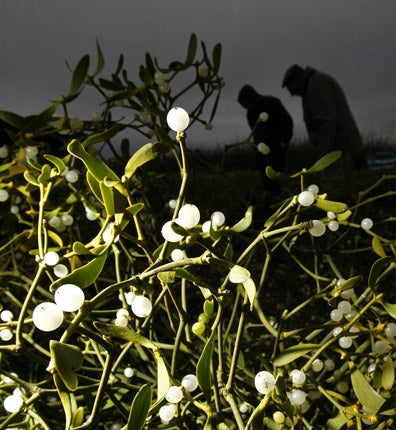Mistletoe: The next sprig thing
It's almost time to get the mistletoe out again – but there's so much more to this plant than meets the eye, says Samuel Muston

Your support helps us to tell the story
From reproductive rights to climate change to Big Tech, The Independent is on the ground when the story is developing. Whether it's investigating the financials of Elon Musk's pro-Trump PAC or producing our latest documentary, 'The A Word', which shines a light on the American women fighting for reproductive rights, we know how important it is to parse out the facts from the messaging.
At such a critical moment in US history, we need reporters on the ground. Your donation allows us to keep sending journalists to speak to both sides of the story.
The Independent is trusted by Americans across the entire political spectrum. And unlike many other quality news outlets, we choose not to lock Americans out of our reporting and analysis with paywalls. We believe quality journalism should be available to everyone, paid for by those who can afford it.
Your support makes all the difference.Running away from over-friendly house guests wielding mistletoe is one of the great traditions of Christmas in England. But what makes this seasonal sprig so special, and why do people insist on trying to kiss us under it?
*Mistletoe is the fulcrum of an entire ecosystem. A versatile and rapacious plant, it is home to a number of invertebrates which are specially adapted to thrive on and around its surface. As well as the "kiss me slow" weevil and four other beetle species, it is also home to the mistletoe marble moth. This extremely rare insect spawns only on mistletoe plants and is subject to a government conservation plan to increase numbers.
*In England we use mistletoe to decorate our front doors, but in Austria it is used as a cancer medicine. The plant is a rich source of toxic lectin proteins (the substance that killed the Bulgarian writer Georgi Markov in the umbrella killing in 1978) which, when refined, can be injected into a patient with cancer. This solution, it is argued, stimulates the immune system into a renewed attack on the cancer cells. Although commonly used by followers of complementary medicine, its efficacy as a cancer treatment has never been satisfactorily proven.
*The mistletoe plant's white berries are a reproductive disadvantage. "The mistle thrush and black cap are the only birds in the UK which recognise the berries as food," mistletoe expert Jonathan Briggs says, "so the plant is seldom seen in areas in which these birds are not. The birds eat the white berries and then egest the seeds within them. This process usually takes place in other trees, so the mistletoe seed ends up just where it wants to be: on a tree branch."
*Mistletoe was worshipped as a divinity by early English druids. "Donning their best robes, they would climb oak trees and cut sprigs of mistletoe from their upper reaches. The sprigs would then be thrown down on to a white sheet below. It was essential, from the druids' point of view, that the berries did not touch the floor or their fertility powers would be lost. The sprig would then be hung over the door of the chief's house," Briggs says.
*"There's been a lot of re-planting of apple trees in the last decade because of booming cider sales," mistletoe auctioneer Nick Champion says. This is ideal for mistletoe, as apple trees are its favoured host tree. So drinking a pint of cider helps to ensure there is plenty of mistletoe at Christmas.
*A semi-parasitic plant, the mistletoe seeds burrow below the outer layer of bark on the host trees. The 5-10mm shoots pierce the tree's growth cells and fool them into thinking they are part of the tree itself. The mistletoe is then able to suck off such water and minerals as it requires. However, the plant can eventually become a victim of its own success. So rapacious can it become that it forces its host into a stress state, which may ultimately lead it prematurely to shed its leaves. In some instances, it pushes the tree to such an extent that it dies. Unsurprisingly, then, orchard managers often employ conservationists to trim back the mistletoe, thus ensuring both plant and tree co-exist for another season.
Join our commenting forum
Join thought-provoking conversations, follow other Independent readers and see their replies
Comments